NORTH WALES COAST RAILWAY:NOTICE BOARD
Rheilffordd arfordir gogledd Cymru: Hysbysfwrdd
21 May 2020
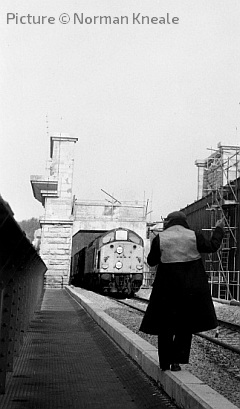
Next update will be on the evening of Tuesday 26 May.
Forthcoming events
(see also our Calendar page for venues)
Note: we have removed all entries up to the end of May as the events are cancelled.
June 2020
Saturday 27 June Steam at Chester The Cheshireman (Railway Touring Company). 60163 London Euston - Chester and return.
July 2020
Sunday 19 July Steam on the Coast North Wales Coast Express (Railway Touring Company) Liverpool - Manchester - Holyhead (15:05 - 17:40).
Tuesday 21 July Steam on the Coast The Welsh Mountaineer (Railway Touring Company) Preston - Blaenau Ffestiniog and return
August 2020
September 2020
Saturday 5 September Steam at Chester 'The Cheshireman' (Railway Touring Company). Norwich to Chester. Loco 6233 for part of the journey.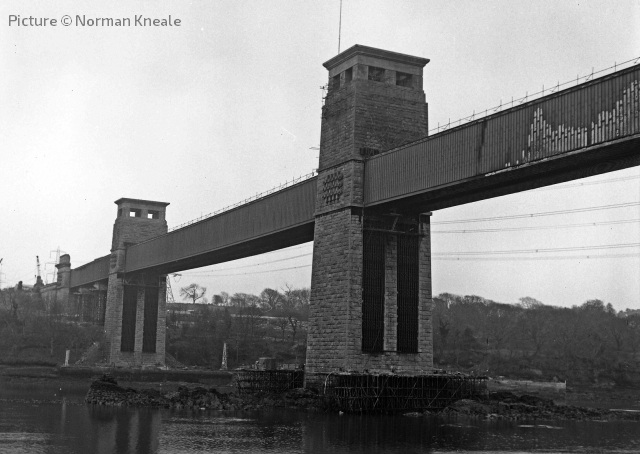
Special issue: The Britannia Bridge fire – 50 years on. By Steve Morris
Saturday 23 May marks the 50th anniversary of a major fire at the Britannia tubular Bridge linking the mainland to Anglesey which resulted in its closure and major rebuilding. Apart from the loss of a direct rail route from Holyhead to London for the first time in over 120 years and subsequent inconvenience, repatriation of a large number of locomotives and rolling stock that were marooned on Anglesey following the closure presented a major challenge in itself. This photo article takes a look back at these events using images recorded by well-known local photographers, including Menai Bridge-based Norman Kneale who was one of the first on the scene and who features in a new documentary “Tan ar y Bont” covering the fire that was first aired on S4C on 14 May. This will remain available on the S4C catch-up service until the middle of June and is well worth a look. (An English language version, 'Britannia's Burning - Fire on the Bridge' will be broadcast on BBC1 Wales at 22:30 on Sunday 24 May and available though iPlayer.) Many thanks to all those concerned for permission to use the images in this article.
During the evening of 23 May 1970 two youths entered the Britannia Bridge up tube at the Caernarvonshire end and lit paper as illumination. Some 12 yards inside, at a point where the main wrought iron tube joined the stonework of the tunnel entrance, the wood/tarred hessian jointing in this area was ignited by the lit paper. The individuals concerned fled the scene but the fire spread rapidly to the highly flammable tarred wooden covering across the top of the two tubes which, coupled with their flue-like construction and moderate breeze, quickly resulted in the small fire turning into an inferno. The first call to Bangor fire station came at 21:43 with fire fighting commencing at the Caernarvonshire end just after 22:00. A request for assistance from the Anglesey fire service came at 22:44 but by now the fire was spreading rapidly. By the following morning significant damage to the tubes had been done, they had lost their mechanical strength with the two centre spans sagging due to shearing and splitting of the joining plates at the centre supporting piers. The heading picture, recorded shortly after the fire, shows the damage sustained. Photo Norman Kneale.
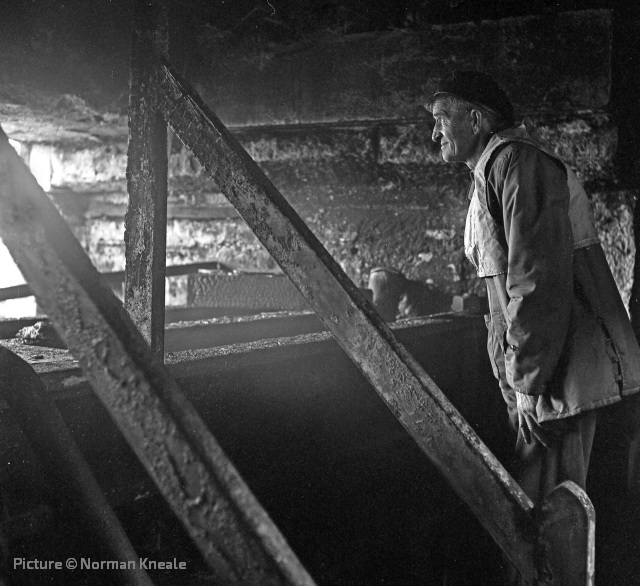
A view from inside the bridge taken the morning after the fire during an inspection of the damage on 24 May 1970. Photo Norman Kneale.
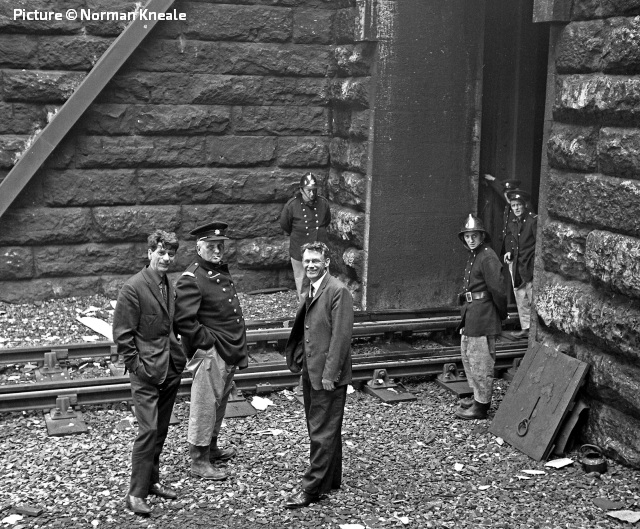
With a look of relief that the fire is out, Firemen and others gather outside the entrance to the bridge shortly after the fire had gone out. It had been a tough night for all concerned. Having tried to fight the fire the order was finally given to evacuate the structure due to a real threat to life and it was left to burn itself out. Photo Norman Kneale, 24 May 1970.
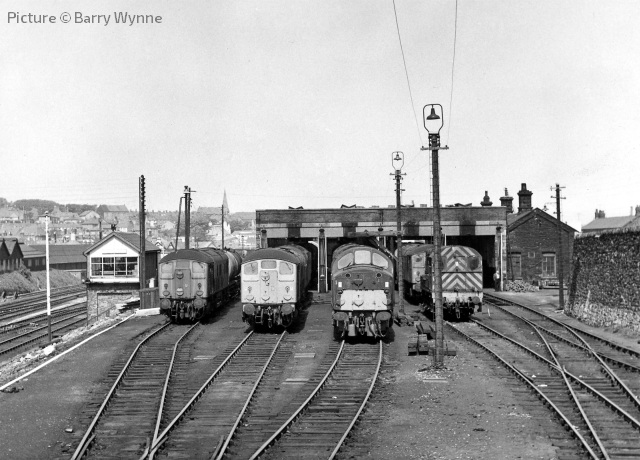
Following the fire, the resident class 01s apart, no less than 13 mainline and 4 shunting locomotives, two DMU cars, 72 coaches and 34 Freightliner flats along with a number of other assorted wagons were effectively "stuck" on Anglesey. As soon as the severity of the damage to the bridge was known a plan was drawn up to move the majority of these to the mainland. Two class 24's, the shunters and a number of coaches and wagons remained on Anglesey throughout the closure. A summary of the locomotive position is provided below. In this image taken the day after the fire, a number of them can be seen stabled on Holyhead shed on 24 May 1970. Photo Barry Wynne.
| Class |
Number | Comments |
| 01 | 2954 (01 001) 2955 (01 002) | Resident at Holyhead Breakwater |
| 08 | 3004 (08 001) 3174 (08 108) 3175 (08 109) 4137 (08 907) |
All remained at Holyhead throughout bridge closure period. |
| 24 | 5034 (24 034) 5044 (24 044) 5083 (24 083) |
5034 and 5083 remained on Anglesey. 5044 shipped to Barrow. |
| 40 | 219 (40 019) 231 (40 031) 232 (40 032) 233 (40 033) 241 (40 041) 307 (40 107) 390 (40 190) |
All shipped to Barrow. |
| 47 | 1724 (47 549) 1851 (47 201) 1940 (47 497/47 717) |
All shipped to Barrow. |
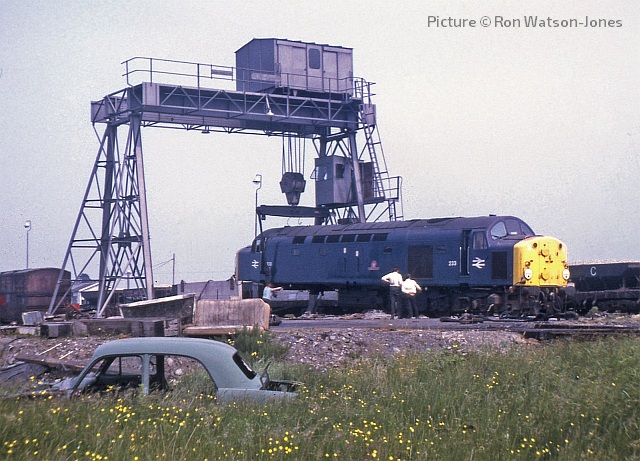
The locomotives that were returned to the mainland had their bogies removed at Valley CEGB sidings utilising the crane that was normally used to load nuclear flasks from the nearby Wylfa power station to trains for onward movement. The bodies were then moved by Pickfords to Holyhead port by road with the bogies being towed there by a class 24. The bodies and bogies were then shipped to the Vickers-Armstrong’s quay at Barrow-in-Furness onboard the 2000-ton Kingsnorth Fisher for re-assembly, a journey that took 12 hours. Following three shipments to Barrow this process was complete within four weeks of the fire. In this image taken on 10 June 1970, class 40 number 233 Empress of England is seen during the bogie removal process in Valley Goods yard. It would finally leave Holyhead port along with three class 47’s on 14 June 1970. Photo Ron Watson-Jones.
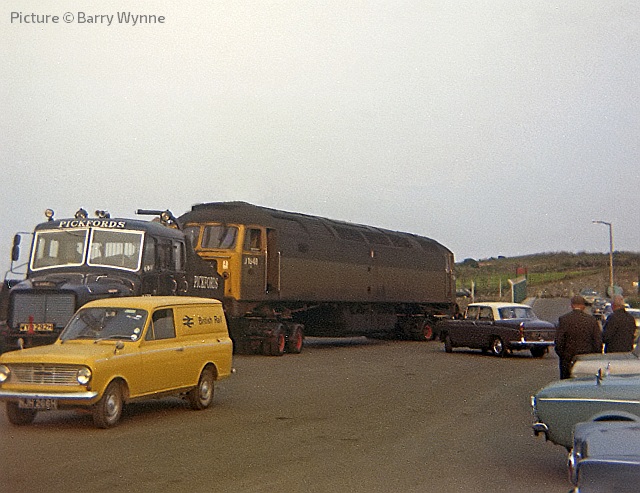
12 June 1970, and Class 47 number 1940 is seen at Holyhead port ready for shipping to Barrow. Photo Barry Wynne.
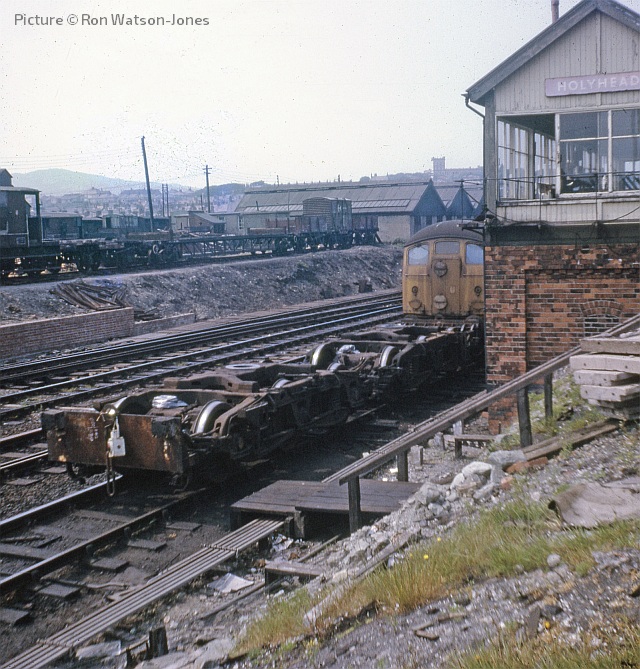
13 June 1970 and class 24 5034 is seen passing Holyhead signal box towing the bogies belonging to class 47 number 1851 from Valley to the port. They would be reunited with their body on arrival in Barrow a few days later. The makeshift nature of this working would certainly not be allowed today...! Photo Ron Watson-Jones.
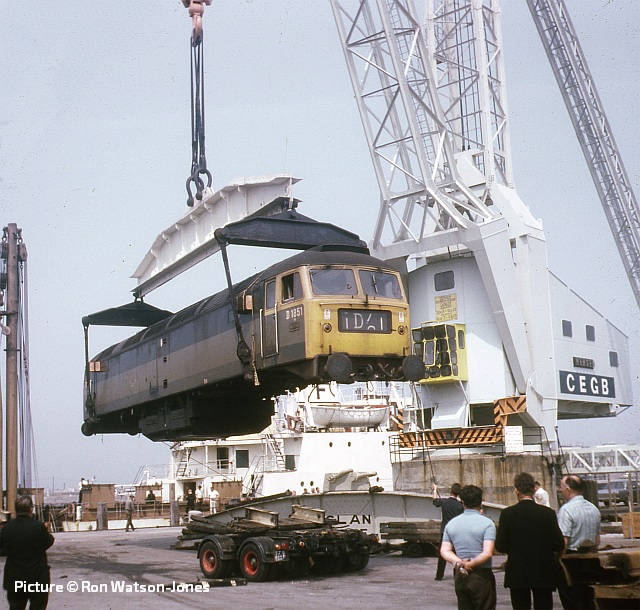
Class 47 number 1851 is seen being lifted from its temporary road bogies onto the Kingsnorth Fisher using the large CEGB crane at Holyhead port. It is 14 June 1970 and the later that day it, along with class 47s 1940/1724 and class 40 number 233, would leave on the first shipment to Barrow. It was fortunate that a suitable crane existed at Holyhead for this purpose. This had been provided by the CEGB to unload materials used in the building of the nearby Wylfa Nuclear power station a few years earlier. Photo Ron Watson-Jones.
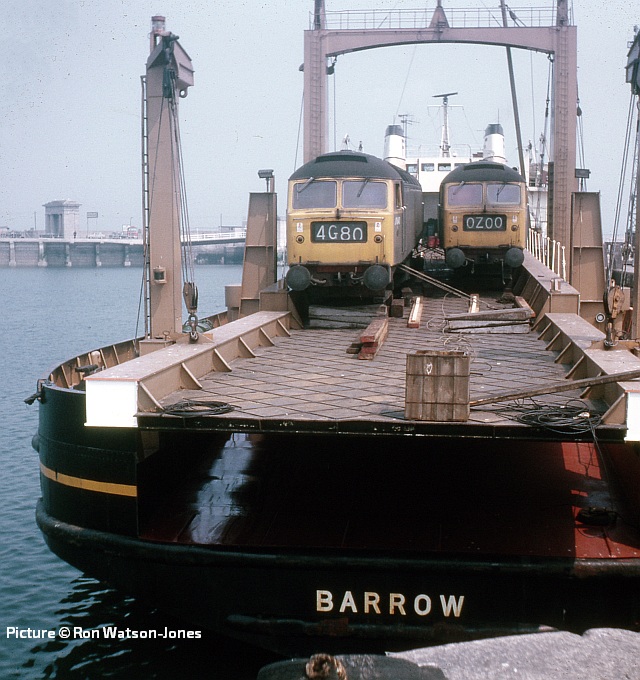
A view of the Kingsnorth Fisher at Holyhead port loaded with class 47s 1940 and 1724 on board waiting loading of 1851 and class 40 number 233 before setting sail for Barrow later in the day. 14 June 1970. Photo Ron Watson-Jones.
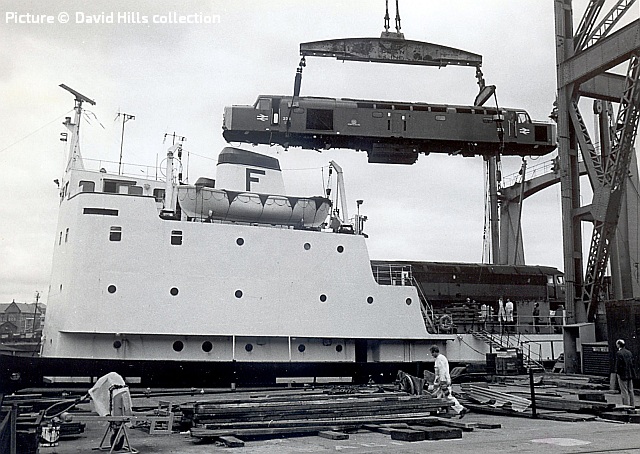
Having arrived at Barrow on 15 June, 233 the first class 40 to be “liberated” is seen in the process of being unloaded. Photo David Hills collection.
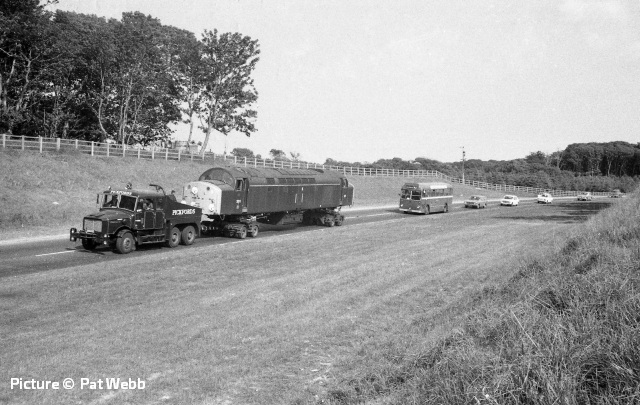
231 Sylvania is seen between Valley and Holyhead being moved by road to the port on 15 June, the date of the writer's 8th birthday; living in Holyhead at the time I was completely oblivious to what was going on...! Photo Pat Webb.
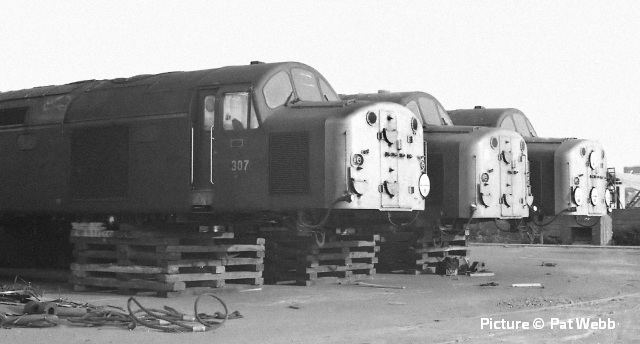
Class 40s 307 / 241 / 231 are seen at Holyhead port on 17 June awaiting return of the ship from Barrow. They would soon be joined by class 40 number 232 Empress of Canada and depart for the mainland on 19 June. The third and final departure took place on 24 June with class 40s 219 Caronia, 390 and class 24 number 5044 on board. Photo Pat Webb.
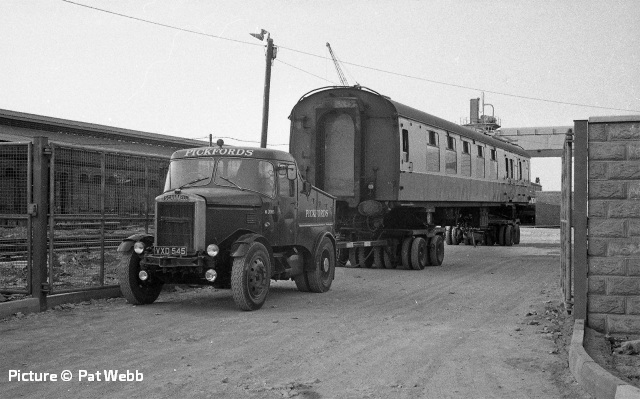
No less than 72 coaches were stuck on Anglesey following the fire. In this view taken in mid June 1970 one of them can be seen beginning its journey by road from Holyhead to Menai Bridge yard where it would be reunited with its bogies. Photo Pat Webb.
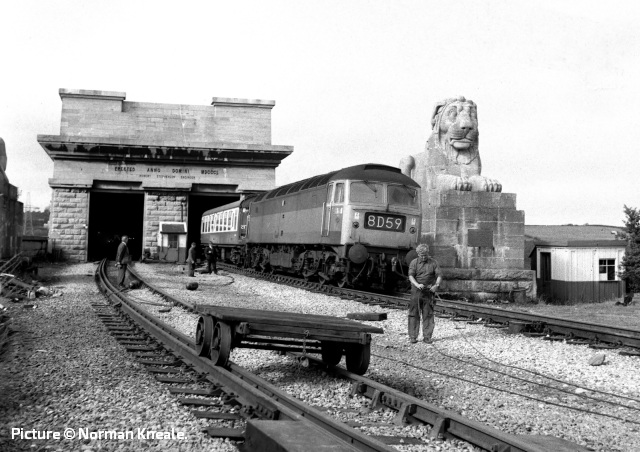
The movement of coaches by road was short lived. One of them damaged the Menai Bridge during transit, the clearance across there being very tight. As an alternative they were individually winched slowly through the remains of the up tube to the mainland. In this view taken during September 1970 one of them has just made the journey across. Class 47 number 1719 (47 128/656/811) is seen waiting to transfer the coach to Menai Bridge yard to join the rest of its rake. Photo Norman Kneale.
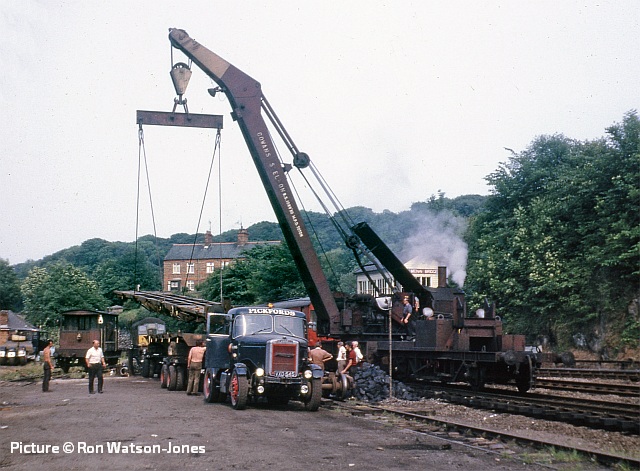
Menai Bridge yard was used to re-unite various items of rolling stock with their bogies using the Toton breakdown crane following transfer by road from Holyhead. In this view taken during June 1970 a container flat wagon body is seen being unloaded from a lorry. Photo Ron Watson-Jones.
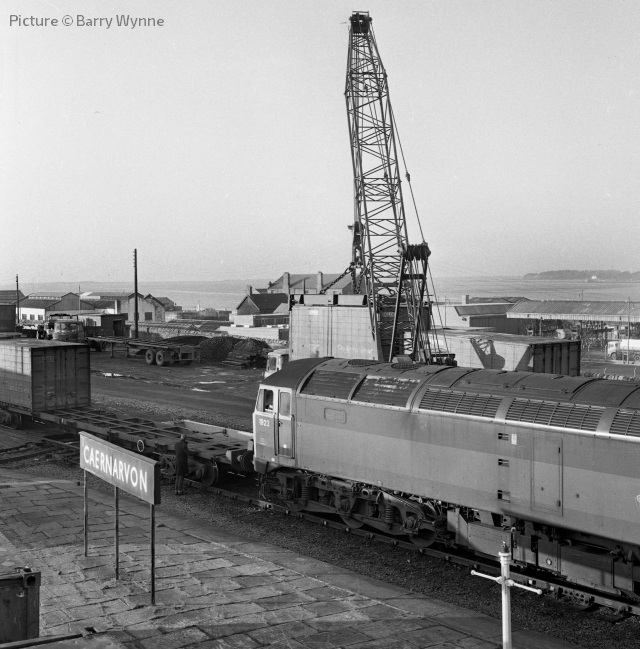
Freight traffic to and from Holyhead was significantly disrupted. The branch from Menai Bridge to Caernarvon, closed in January 1970, was reopened on 15 June to permit continuation of the recently introduced Freightliner traffic, the containers being moved to and from Holyhead port by road. During the closure period over 26,000 containers were dealt with this way. In this view taken during the summer of 1971 Class 47 number 1923 (47 246/644/756) is seen with its train being unloaded adjacent to the closed Caernarvon station. Having arrived early in the morning as 4D50, a 23:45 departure from Willesden, the containers would be swapped for others from Holyhead port to make the return journey as 4A41 at 15:15 in the afternoon. Photo Barry Wynne.
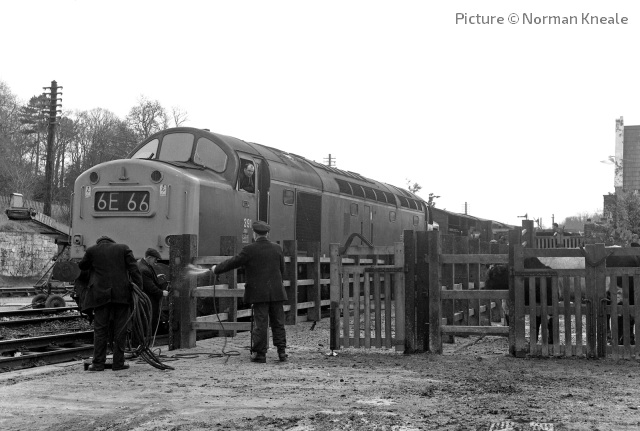
Another important source of freight traffic out of Holyhead was imported Irish Cattle. Following the fire this was transferred to Heysham and Birkenhead for several months until re commencing in November 1970. The livestock was taken by road from Holyhead to a temporary loading facility located at the closed Menai Bridge station for onward movement to York. Between November 1970 and January 1972 over 105,000 cattle were moved this way. Running Saturdays excepted, the empty wagons would arrive as 6D35 from Shrewsbury Coton Hill early in the morning returning as 6E66 to York at 17.43. In this view taken on March 14 1971, class 40, 391 (40 191) is seen waiting final loading and departure from Menai Bridge. Photo Norman Kneale.
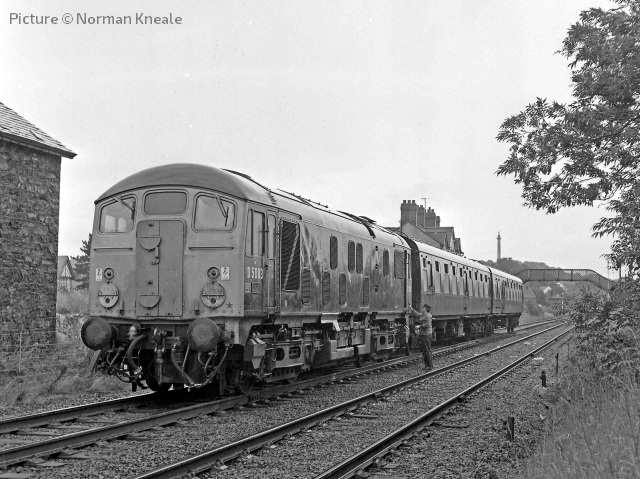
As far as passenger traffic was concerned, within days of the fire a temporary platform was built on the up side of the closed Llanfair PG station. This was served by trains from Holyhead with a bus connection to Bangor. There were typically five return services per day which were operated by a two car DMU, numbers 56167 and 50404 until October 1970 before being replaced by 51198 and 56355, the exchange being made by winching the vehicles concerned through the damaged up tube of the bridge. In addition, two class 24s, numbers 5034 and 5083 remained on Anglesey throughout the 20-month bridge closure and also ran these services with two or three MK1 coaches. In this view 5083 is seen having just run around its train at Llanfair PG waiting a return to Holyhead during March 1971. Photo Norman Kneale.
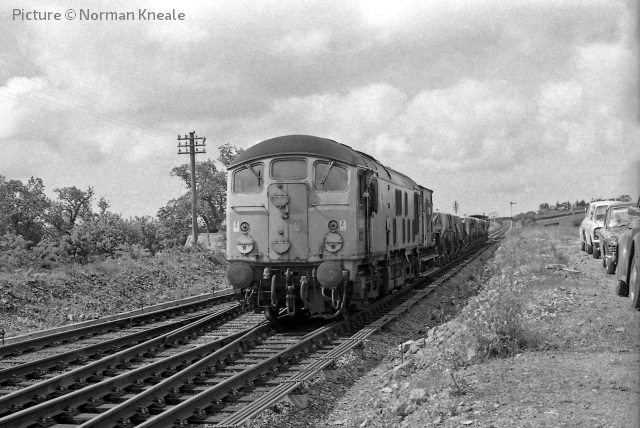
Imported raw sulphur for use by Associated Octel was moved from Holyhead Port to the plant at Amlwch using one of the two class 24s left on the island. Fifty hopper wagons were winched across the damaged bridge onto the island for this purpose and they moved 22,000 tons of sulphur during the closure period. In this view taken during the summer of 1971, 5083 is seen arriving at Gaerwen on such a train before running around and taking the Amlwch branch seen to the right. Photo Norman Kneale.
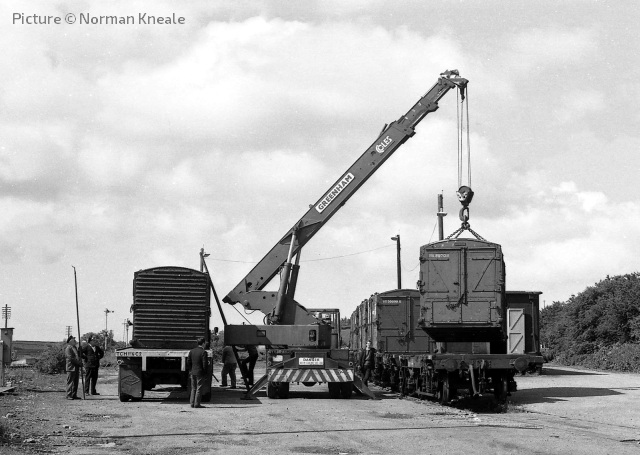
Almost 18,000 first generation IS/BD wooden bodied containers with a maximum payload of 4 Tons were moved by train from Holyhead to a re-opened Gaerwen goods yard to allow road transport to Bangor and onward shipment by rail. In this view taken during the September 1971 one of these containers is seen being unloaded from its train in Gaerwen yard. Photo Norman Kneale.
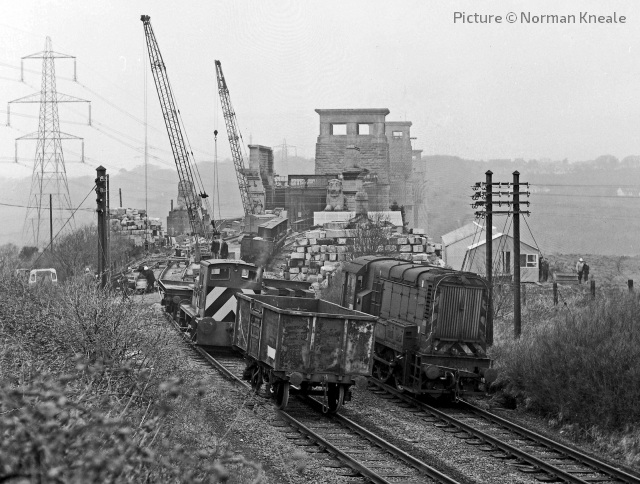
The damage caused by the fire was so severe that a complete rebuild was required. Fortunately this was authorised and progressed as a priority. In short, the project involved installation of new steel arches that were fabricated at the nearby Port Dinorwic harbour and floated to the site. These supported the main tubes along with steel girders and supporting columns underneath the shorter “land connection” sections at either end. In this view taken on February 7th 1971 the rebuild project is well underway. Llandudno Junction based D3084 (08069) is pictured positioning several new steel girders at the Caernarvonshire end of the bridge. Photo Norman Kneale.
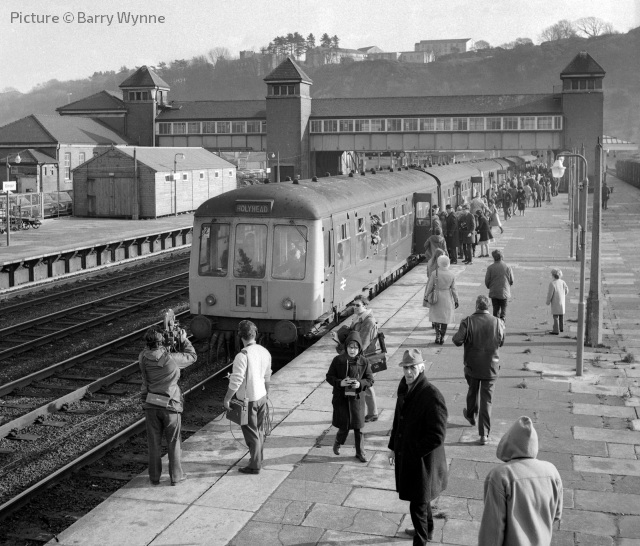
The addition of steel arches to strengthen the structure allowed the bridge to reopen using the up tube only on 30 January 1972, a number of tests having been conducted using a rake of 100 Tonne tankers hauled by class 47 number 1843 (47 193) a few weeks before. Following a class 24-hauled officers saloon special was a special working for the general public from Bangor to Holyhead made up of an eight car DMU. In this view it can be seen waiting departure from Bangor with plenty of media attention in view. Photo Barry Wynne.
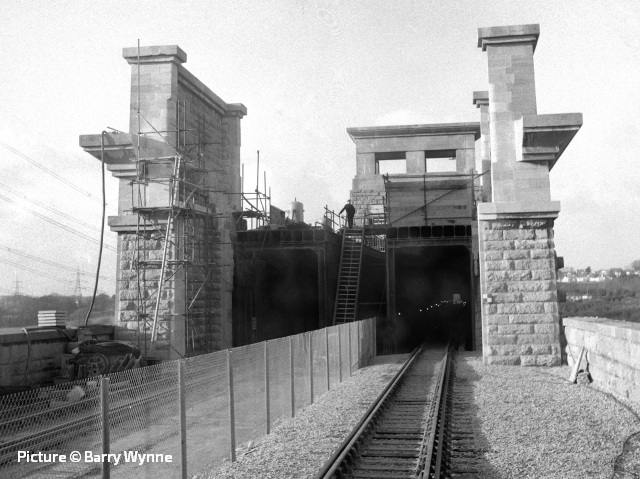
The first public train to use the Britannia Bridge since the fire is seen about to enter the up tube en route Holyhead. Barry has certainly secured a prime spot to record this image! At this stage the tubes remain in situ, but not for much longer. 30 January 1972. Photo Barry Wynne.
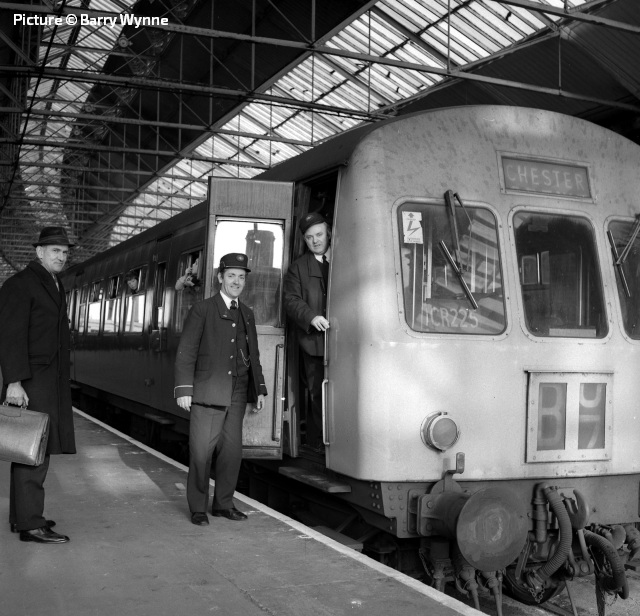
Traincrew and other staff pose with the return special DMU to Bangor at Holyhead station. Anybody out there recognise them? Photo Barry Wynne.
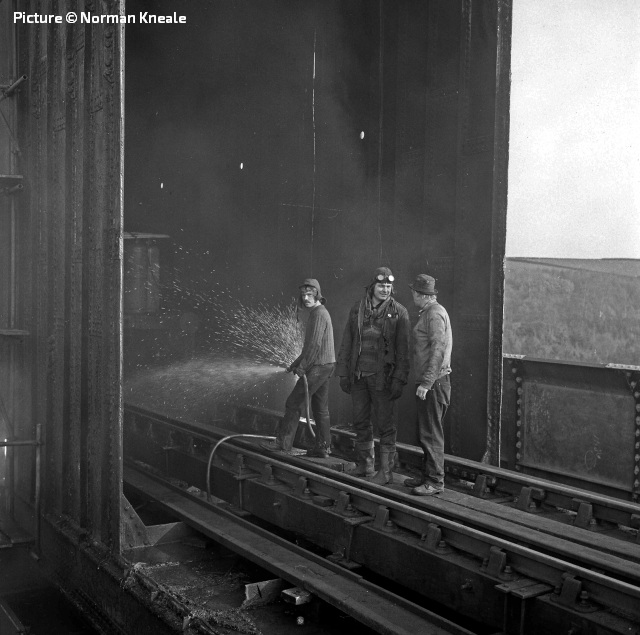
Following re opening of the Up tube the Down tube was cut up into sections and removed piece by piece over a period of several years. In this view the Oxy-Acetylene gang can be seen at work. Photo Norman Kneale.
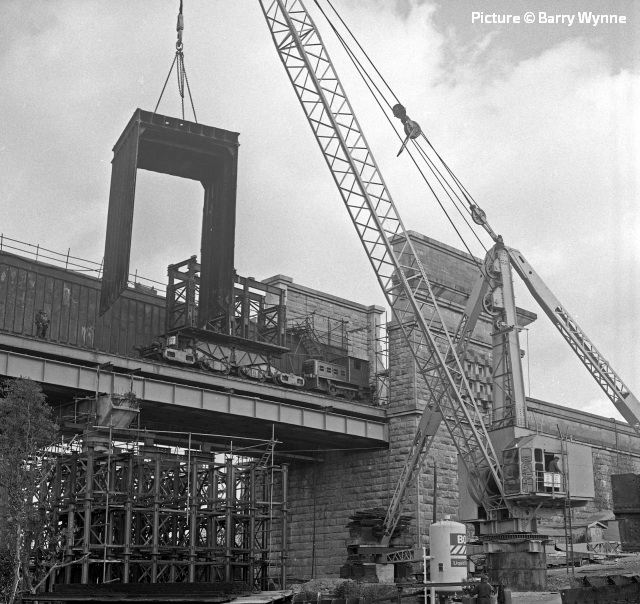
A September 1972 view of the Down tube removal in full swing. A section has been moved to the mainland end of the bridge utilising a 80HP John Fowler Industrial shunter number 185 David Payne which was present on site until 1975. Photo Barry Wynne.
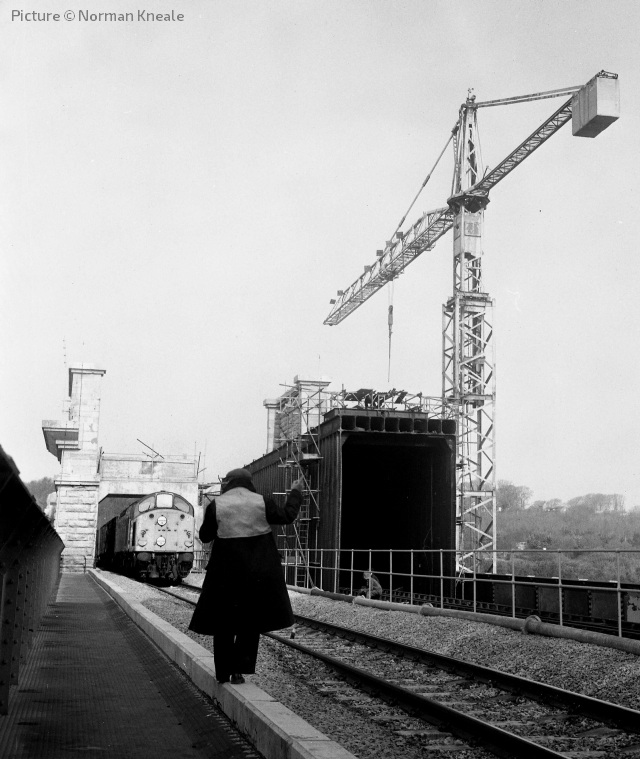
The down tube has now been removed and traffic transferred to that side allowing removal of the up tube to begin. In this view taken on April 9th 1974, class 40 number 310 (40 110) is seen heading an up Freightliner across the bridge. Traffic remains on the down side to this day with the other side being used to carry various services (cables, etc.) between the mainland and Anglesey. Photo Norman Kneale.
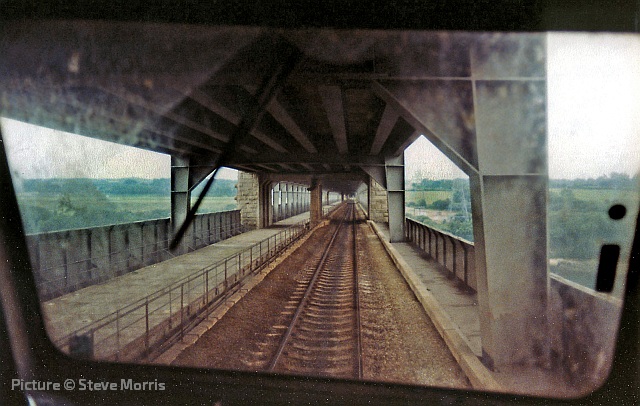
The rebuilt bridge was designed with the addition of a road deck above the railway in mind. This commenced in 1978, was completed in May 1980 some ten years after the fire, and now forms part of the A55 Chester to Holyhead Expressway. Here the bridge is seen in its final form from the cab of 47 475 working the 12.52 Holyhead to Crewe on 7 September 1981. The new road deck sits above the railway which now occupies what was previously the down line. Photo Steve Morris.
North Wales Coast home page | Archive | Previous Notice Board